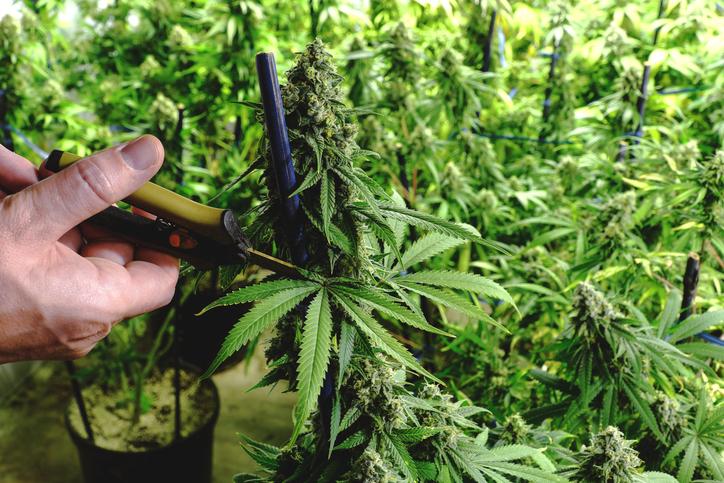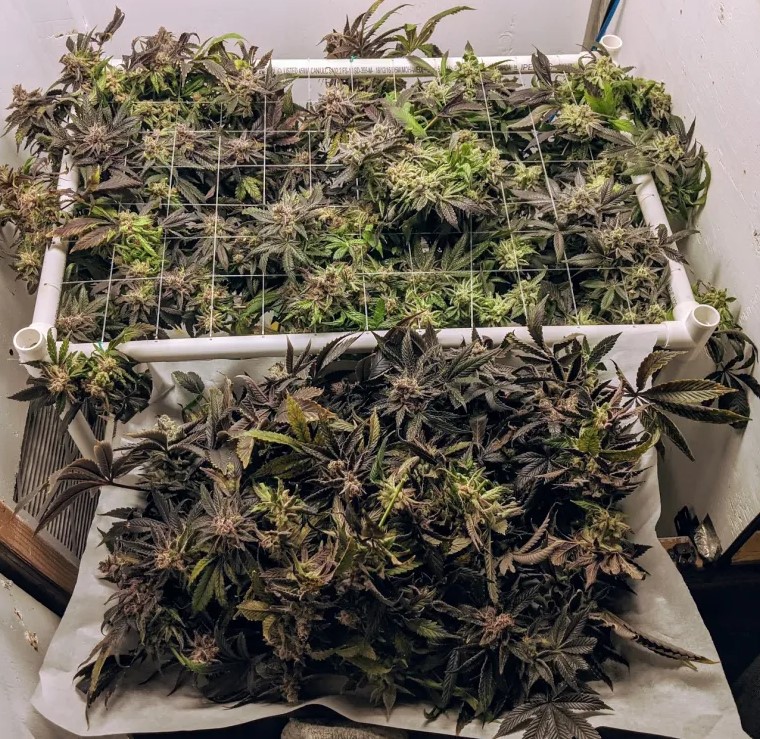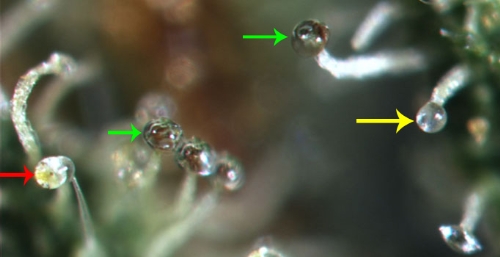Staggered harvest is a technique that has become increasingly popular among cannabis growers in recent years. This method involves harvesting different parts of a cannabis plant at different times, resulting in higher yields and better quality buds. In this article, we’ll explore the benefits of staggered harvest, how to implement it in your grow, and tips for achieving the best results.
Table of contents:
- What is staggered harvest?
- Benefits of staggered harvest
- How to implement staggered harvest in your grow
- Tips for achieving the best results
What is staggered harvest?
Staggered harvest, also known as selective or progressive harvest, is a cannabis cultivation technique that involves harvesting different parts of a plant at different times. Instead of harvesting an entire plant at once, growers selectively remove mature buds, allowing the remaining flowers to continue to develop and mature.
This technique is typically used during the flowering phase of a cannabis plant’s growth cycle, when buds begin to develop and mature. By selectively harvesting mature buds, growers can increase their yield and improve the overall quality of their product.
Staggered harvest can be done in a number of ways, depending on the grower’s goals and the specific strain of cannabis being cultivated. Some growers may choose to harvest the top buds first, while others may opt to harvest the lower buds first. Some growers may also choose to stagger their harvest over several weeks or even months, depending on the size of their grow and their available resources.
One of the primary benefits of staggered harvest is that it can help to prevent over-ripening or under-ripening of buds. By selectively harvesting mature buds, growers can ensure that their plants produce the highest quality buds possible.
Another benefit of staggered harvest is that it can help to maximize yields. By allowing the remaining buds to continue to develop and mature, growers can produce a larger overall yield than they would with a single harvest.
Overall, staggered harvest is a valuable technique for cannabis growers who are looking to maximize their yields and produce high-quality buds. With the right approach and attention to detail, growers of all experience levels can successfully implement staggered harvest into their cultivation process.
Benefits of Staggered Harvest
Staggered harvest provides a range of benefits for cannabis growers. Here are some of the key advantages:
- Increased Yield: Staggered harvest allows growers to maximize their yield by selectively harvesting mature buds while allowing others to continue to develop.
- Improved Quality: By harvesting buds at their peak of maturity, growers can produce high-quality cannabis that is rich in cannabinoids and terpenes.
- Reduced Risk of Loss: By staggering the harvest over several weeks, growers can reduce the risk of losing their entire crop due to pests, disease, or other issues.
- More Efficient Use of Resources: With staggered harvest, growers can make more efficient use of their resources, such as lighting, nutrients, and space.
- Customized Harvest: Staggered harvest allows growers to customize their harvest based on their specific needs and preferences, such as harvesting the top buds first for a higher quality product.
Overall, staggered harvest is a valuable technique for cannabis growers who are looking to improve their yields and produce high-quality buds. By selectively harvesting mature buds and allowing others to continue to develop, growers can achieve a more efficient, effective, and customized harvest.
How to Implement Staggered Harvest in Your Grow
Staggered harvest can be a bit of a learning curve, but with the right approach, it can be an effective technique for maximizing your cannabis yield. Here are some simple steps to help you implement staggered harvest in your grow:
- Identify the Right Strain: Start by choosing a strain that is well-suited for staggered harvest, such as a strain that has a longer flowering period or produces multiple main colas.
- Determine Your Harvest Schedule: Decide how long you want your staggered harvest to last, and plan out a schedule for harvesting different parts of the plant at different times.
- Keep Detailed Records: Keep detailed records of your harvest schedule, including the date and time of each harvest, the location of the harvested buds, and any notes about the quality of the product.
- Harvest Mature Buds: Begin your staggered harvest by selectively harvesting mature buds, starting with the top buds and working your way down.
- Leave Some Buds to Mature: Allow some of the buds to continue to develop and mature, monitoring them closely for signs of maturity.
- Repeat the Process: Continue to harvest mature buds and allow others to mature until you have harvested all the buds from the plant.
- Rinse and Repeat: Once you have completed your first staggered harvest, rinse and repeat the process for your remaining plants.
By following these simple steps, you can effectively implement staggered harvest in your grow and maximize your cannabis yield. Remember to keep detailed records and monitor your plants closely to ensure that you are harvesting your buds at the right time for the best possible results.
Tips for Achieving the Best Results with Staggered Harvest
Staggered harvest can be a complex technique, but it can also yield impressive results. Here are some tips to help you maximize your yield and produce high-quality cannabis with a staggered harvest:
- Use Magnification Tools: It’s important to harvest your buds at the right time, which means monitoring trichome development. Using magnification tools like a jeweler’s loupe or a microscope can help you assess trichome color and maturity.
- Harvest Larger Buds First: When selecting which buds to harvest first, it’s generally best to start with the larger, more mature buds. This allows smaller buds to continue developing, resulting in a more efficient harvest overall.
- Be Mindful of Lighting: As you harvest buds selectively, it’s important to consider the lighting needs of the remaining buds. Be sure to adjust your lighting to suit the needs of the remaining plants, and avoid leaving any plants in the dark for too long.
- Use a Clean, Sterile Environment: Proper hygiene and cleanliness are essential for avoiding contamination during staggered harvest. Use clean tools and equipment, and maintain a sterile environment to minimize the risk of mold, pests, or other issues.
- Practice Good Training Techniques: Proper plant training can help you achieve more consistent results with staggered harvest. Consider techniques like topping, training, or supercropping to encourage even growth and maximize your yield.
- Consider Using a Trellis: A trellis can be a helpful tool for supporting plants during staggered harvest. By providing support to the remaining buds, a trellis can help prevent damage or breakage as you harvest individual buds.
By following these tips, you can achieve the best possible results with staggered harvest in your cannabis grow. Remember to use magnification tools, harvest larger buds first, be mindful of lighting, maintain a clean and sterile environment, keep detailed notes, practice good training techniques, and consider using a trellis.
When to Implement Staggered Harvest
Harvesting cannabis at the right time is crucial to ensure maximum potency and crop yield. In general, female cannabis plants should be taken down during the brief window of their peak ripeness, before the medicinal compounds start to degrade. However, determining the optimal time for harvesting cannabis can be challenging since there are many factors that affect the ripeness of the plant, such as cultivars, individual plants, and environmental conditions.
Experts offer conflicting advice on when to harvest, depending on personal preference, with some suggesting an earlier harvest for a more uplifting, cerebral effect while others recommend a later harvest for a more calming effect. Strains or cultivars also express their ripeness differently, with varying outward signs of the optimal harvest point. For example, some Sativa cultivars prefer a longer flowering period of up to 16 weeks, while Indicas may flower in as little as 5 weeks.
It is important to harvest at the right time because if the harvest is too early, the potential potency of THC may not have been realized yet, while a delayed harvest may cause THC to degrade into another less-desirable cannabinoid known as cannabinol (CBN). CBN has sedative and anti-anxiety properties that some patients might value, but most users prefer a higher THC or CBD concentration without sedation.
Trichomes and pistils are the best visual indicators of when to harvest, with both changing color or shape as the plant reaches maturity. Trichomes slowly change color from clear to milky-white as the plant matures, with opaque milky-colored trichomes indicating that resin production has peaked, and secondary metabolites like THC, CBD, and terpenes are at their maximum. Pistils change color and take on a brown or orange hue when the plant approaches maturity, indicating that the biological functions of the plant have slowed and it is no longer seeking pollen for seed production.
In general, most cultivators who use the trichome method for harvesting take down their plants when more than half of the trichomes have turned from clear to cloudy and just a few are amber. If most of the trichomes are amber, the plant is past its peak. On the other hand, most cultivators who base their harvest date on the pistil method take down their plants when 70% of the pistils have changed color and curled inward. If 90% of the pistils are brown/orange, the plant is past its peak. Finally, cultivators with access to chemical testing equipment can track their crop’s cannabinoid concentrations to pinpoint the optimal harvest time.




Greetings! I chopped mine all in one go, but next time I am gonna try staggered harvesting